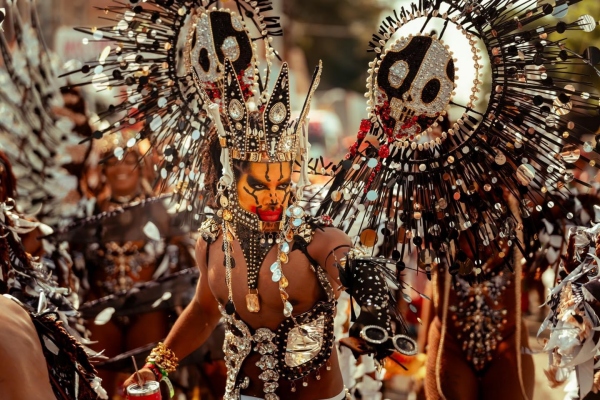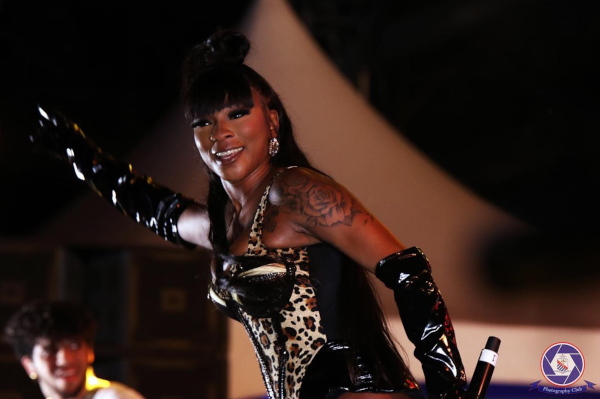The National Carnival Commission (NCC) may have done more harm than good to the soca music industry by putting money into Soca Monarch.
Soca Monarch organisers decided to give the so-called Power Soca more relevance and importance than the so-called Groovy. They decided to pay the Power Soca winner twice as much money than the Groovy winner, and to recognise the Power Soca category winner as the official Soca Monarch.

Not too long after that announcement, the defending Soca monarch, Aaron ‘Voice’ St Louis, who sings groovy, Nadia Batson and Darryl ‘Farmer Nappy’ Henry decided they were not going to enter the competition. I agree with them on not entering, since the organisers were indirectly telling them, their work was substandard to Iwer George’s Blessings, Hollis ‘Mr Killa’ Mapp’s Run Wid It and the other Power Soca songs, which most people can not remember today.
One can argue the NCC, by providing funding to Soca Monarch, helped dampen and suppress the more internationally marketable tunes like Batson’s Long Time, Farmer Nappy’s Hookin Meh and Alive and Well. I strongly believe we would have seen just as much crowd response for Long Time and Hookin Meh as we saw for Mr Killa’s Run Wid It.
Some of International Soca Monarch (ISM) chairperson Fay Ann Lyons-Alvarez’s arguments for the return of the Power Soca category were because local soca singers were not ‘mashing up fetes’ like several acts from other islands. She also pointed to a soca cruise at which the audience reacted more enthusiastically to performances from entertainers from other Caribbean islands—without telling us who the Trinidad and Tobago performers were on the cruise.
For me, Fay Ann’s arguments are flawed. She failed to recognise that while she’s clamouring for more power soca, 78 year old Linda ‘Calypso Rose’ Sandy-Lewis—who does not perform power soca—sold out 150 shows in Europe with 68,000 people in one show alone.
Meanwhile, Olatunji Yearwood was toasted by millions of people on UK talent show X Factor singing groovy Soca—a breakthrough that was not leveraged by our Carnival controllers who did not see it as worthwhile to leverage Olatunji’s image to the millions of viewers now familiar with his music.

(Copyright Allan V Crane/CA-Images/Wired868)
If power soca really was the superior type of soca music, it would win the Soca Monarch on its own merit. It would not need its own category; it does not have to be guaranteed to be paid twice as much as groovy. It should not be given assurances that it will be the only type of song to be crowned as the official Soca Monarch.
The only thing such a decision achieves is to motivate the young crop of soca performers to forgo the melodious music and appealing delivery that clearly has a massive market.
After years of criticism and stagnation, the current crop of soca stars found their collective voices and made music which most people found enjoyable. One can argue the trajectory towards this year’s ‘groovy’ music started in 2011 with Rodney ‘Benjai’ Le Blanc’s I’m ah Trini, which sampled Ed Watson’s music. The other big song that year was Kees Dieffenthaller’s Wotless.
Both I’m ah Trini and Wotless had life after Carnival 2011, with many bookings for the performers while Kes the Band even made it onto mainstream American morning television.
By 2013, Ian ‘Bunji Garlin’ Alvarez’s Differentology got recognition in Europe and the United States and discussion on soca’s crossover to the international stage was resuscitated. Upcoming soca artistes would have also noticed that Farmer Nappy’s Big People Party in 2014 was another song with ‘legs’ or ‘life’ that extended long after the carnival festivities.

(Copyright Allan V Crane/CA-Images/Wired868)
The ability to be booked in the global diaspora, after all, allows artistes to make a good living and be truly considered successful by many of us in the calypso and soca broadcasting world.
By 2016, the trend was obvious; sweetness was back in soca music. At the same time, the Soca Monarch competition was faced with the retirement of mega star Machel Montano.
The ISM management appeared to take note of the trend of the young soca acts and dropped the Power and Groovy categories. Regardless of the tempo of the music, one person was to be crowned as Soca monarch.
Voice became an ISM sensation. He won three times in a row between 2016-2018 with tunes that found favour amongst all generations. The music won.
In 2017, Ultimate Rejects’ Full Extreme took the Road March almost unanimously. Again, it was a song which went back to the foundation of T&T’s music with obvious brass lines.
Groovy soca, which to me is the calypso of this era, was being heard in restaurants, weddings and clubs throughout my travels. The biggest song after Carnival 2018 was Kes’ Hello and the social media was abuzz with various musicians reworking the hit.

Voice also had his say with The Year for Love. And steel band arrangers must have been in their glee as they chose from the melodious music put out by our young crop of singers, writers and arrangers.
However, Soca Monarch attendances dwindled. The argument made by many—and supported by my London-based counterpart, Ian ‘Socapro’ Henry—was that the ISM’s shrinking turnouts came due to the removal of the Power Soca category. I believe that is false.
Did the audience increase this year with the return of Power Soca? If groovy songs were beating power songs fair and square, based on audience response, what is the problem?
Even with all our Grenadian brothers and sisters who flew in to support Mr Killa in this year’s Soca Monarch, the attendance was nowhere close to the turnout at any of the top ten local fetes. The Soca Monarch audience has shifted to Machel Monday.
To assume any other reason for the decline of the Soca Monarch attendance, is to deny Anthony ‘Chinese Laundry’ Chow Lin On and Machel their due credit as marketing and promotional wizards.

(Courtesy Sean Morrison/Wired868)
Since then, Kes started “Kes on the Rocks Tuesday” which grew in popularity with every Carnival season until its 2019 show was ‘ram out’ at the Queen’s Park Oval.
Most people agree this was one of the better year for soca music. Nadia Batson wrote three songs which will have life after Carnival: Long Time, Hookin Mih and Stranger. Patrice Roberts, Voice, Olatunji, Aaron Duncan and Kes, to name a few, all put out music capable of appealing to non-West Indians.
By deciding that power soca is more relevant than groovy, Soca Monarch organisers—aided by the NCC with taxpayer’s money—demoted and undervalued the excellent work that audiences have clamouring for from our soca performers.
Let us hope good sense prevails next year, and the NCC stays out of the soca business. Let’s not do to soca what we did to calypso with the infusion of government funds.
The business of soca is alive and well. Leave it with the private sector. It does not need the NCC to be picking winners and eventually creating losers by pumping money into any one genre of the industry.

(Copyright Allan V Crane/CA-Images/Wired868)
Eric A St Bernard is a host and producer of Global Soca on TeamSoca.com, the #1 Total Soca station in the world. He holds a MSc in TV/Radio from Brooklyn College and has worked extensively in Caribbean music formats in Trinidad and New York, as well as events promotions and media advertising.
 Wired868 Wired868 for smart sport news and opinion
Wired868 Wired868 for smart sport news and opinion







Just had a proper read and there are a couple parts of the article that I don’t logically agree with which I will elaborate on later on below.
However I agree that with the evolution of Soca music both the ISM Groovy Soca Monarch and Power Soca Monarchs now deserve equal respect and prize monies but I also understand Fay-Ann’s reasons and strategy in giving the Power Soca Monarch the bigger slice of the prize monies this year (until more funding and sponsors come on board ) as it helps to signal a reversal in the victimization and discouragement that was metered out to Power Soca artists who have entered the ISM competition over the last few years between 2016 and 2018.
Also we must not forget that traditionally ISM has always given the Power Soca Monarch category a larger prize purse than the Groovy Soca Monarch category due to how both the Groovy and Power Soca categories were introduced to the competition back in 2005.
Let’s not forget that in 2005 the Groovy Soca Monarch was created and introduced to give space and encouragement to artists singing slower paced Soca songs because up until then only one artist and song in ISM’s long history since its inception in 1993 had won the competition singing a slower to mid-tempo song (below 135 bpm) and that was Shadow with his hit “Stranger” in 2001 that also won the road march that year.
All the other ISM winners before 2005 were in fact uptempo Jump & Wave style soca songs which were rebranded as Power Soca songs in 2005 when the separate Power Soca and Groovy Soca categories were introduced.
So in 2005 the regular ISM competition which the uptempo soca songs had clearly dominated was rebranded the Power Soca Monarch competition and an extra competition called the Groovy Soca Monarch competition was introduced to give soca artists singing the slower paced songs a chance to annually win an ISM title.
So naturally the Power Soca Monarch kept the same prize monies and prize structure in 2005 as previous ISM competitions and extra sponsors and prize monies had to be found to give the Groovy Soca Monarch contestants a decent incentive to put out their very best.
This is the history of why the Groovy Soca Monarch competition has always traditionally had a smaller prize purse than the Power Soca Monarch competition and that prize structure worked very well up until 2016 when the competition was merged back into an All-in-one competition due to the rise in quantity and quality of Groovy Soca Monarch songs over the years.
However as we clearly saw between 2016 and 2018 that the All-in-one competition for the ISM has allowed and led to the side-lining of Power Soca artists and with that a massive fall in public attendance to the ISM to the point where last year for the 2018 episode the promoters could not even give away free tickets to encourage more of the public to attend the Finals even with some of the most popular Groovy Soca songs and artists being in the ISM Final.
So in to the rescue came Fay Ann Lyons- Alvarez as the new chair of the ISM competition for the 2019 edition and Fay-Ann knowing and understanding the history of what made ISM a great success and attraction in the past as a contestant, wisely heeded my annual public calls on facebook, etc since 2016 to bring back the separate Groovy Soca Monarch and Power Soca Monarch categories to the ISM competition.
And just as I predicted with the return of power and the separate Groovy Soca Monarch and Power Soca Monarch categories coupled with better promotion and management of the ISM show, we have now seen a massive turn around in the demise of the ISM competition this year with the return of excited flag waving crowds and the future for the ISM competition now looks bright once again.
Anyone who fails to give due credit to the return of separate Groovy Soca and Power Soca categories to ISM for helping to bring back the crowds and excitement to ISM this year has to be living in serious serious denial.
The theory that St Bernard tabled in above article that because Machel Monday is now the biggest show in T&T Carnival that they have taken away the ISM crowd and so there is no way back for ISM because of Machel Monday makes zero sense to me.
Firstly Machel Monday is on a different day to Fantastic Friday and there is no logical reason why most folks who attend Machel Monday cannot also attend the ISM Finals on Fantastic Friday once they have budgeted for both shows.
In fact because Machel Monday falls four days before Fantastic Friday artists who are booked for Machel Monday who have also qualified for the ISM Finals can actually use Machel Monday as a platform to promote themselves and their ISM Final song to encourage their supporters who attend Machel Monday to also come out and support them at the ISM Finals on Fantastic Friday and so help them to cop the top prize.
Finally calling for the NCC not to support the ISM when the ISM could turn out to be one of the biggest shows and tourists attractions in T&T Carnival once again provided it is properly managed, promoted and supported has to be one of the most short-sighted arguments one can table in supposed support of the ISM in my eyes.
Yes I agree that the Groovy Soca Monarch segment of the competition has grown over the years and now deserves equal respect and prize monies as the Power Soca Monarch segment but how is calling for NCC not to support the ISM going to help Fay-Ann and her team to acquire enough prize monies to give both the Groovy Soca Monarch and Power Soca Monarch winners $1 million each for the first prize in each category and to also give 2nd and 3rd place winners in each category equal financial prizes?
I don’t see the logic at all in such a call to the NCC and sighting a waste of T&T taxpayers money as justification for the call when ISM has the potential to attract a lot of regional supporters from the other Caribbean islands to come to T&T to support their country’s soca artists once they make it into the ISM Semi-Finals and Finals?
That’s my feedback on above “Stop Messing With Our Groovy Soca; Why NCC Is Doing More Damage Than Good” article.
It is a well intentioned article but I don’t agree that what it proposes will help ISM and It’s Fantastic Friday to flourish and grow and fulfill its potential as a positive influential BIG brand event within T&T Carnival.
victimization and discouragement ? I’m intrigued – got any details on this?
Antoinette Sankar Go speak to Iwer George and all the other T&T Soca artists who have spent good money on releasing good Power Soca tunes between 2016 and 2018 and ask them how they think their songs were treated by both the radio stations and also the ISM judges.
Ask them how many of them were able to progress from ISM Semis to the Finals and if they believe there was a covert campaign to suppress any Power Soca songs making it to the ISM Finals during that period and see what reply you will get.
Fay-Ann is well aware of the anti-Power Soca agenda being exercised in the ISM between 2016 and 2018 hence why she dubbed the 2019 edition the “Return of Power Soca”.
Sometimes we have to use our third eye and read between the lines as not everyone will openly spell out the politics that was happening to artists behind the scenes.
Ian Socapro Henry Mashup wasn’t just some rhyming words, there was truth there – so I can’t share your views on Iwer. You spoke of victimisation above as regards to artistes entering the competition but the only explanation you give is re the judging (which may very well be an area that could have benefitted from some transparency I don’t deny) but with no details…. Are you saying then that the artiste that won during those years was somehow favoured over Power Soca artistes by the judges? Have those judges been changed? Were these judges presiding over other contests prior to 2016 or was it a new panel that began in 2016?
Antoinette Sankar I am simply saying there was a biased against Power Soca songs making it to the ISM Finals between 2016 and 2018 and that fact was evidence by the few to zero Power Soca songs that made it from the Semi Final stage to the Final during that period.
Artistes who had both Power Soca and Groovy Soca songs released for the T&T Carnival seasons between 2016 and 2018 were also discouraged from choosing to sing their Power Soca songs in the Semis and Final due to lack of radio airplay for their Power Soca song.
The ISM Soca Monarch competition between 2016 and 2018 was in fact a Groovy Soca Monarch competition in reality without using the word Groovy hence why Fay-Ann who is aware of the politics dubbed this year’s edition of the ISM as the “Return of Power Soca”.
Ian Socapro Henry Do you know who the judges were?
Antoinette Sankar Why do I need to know who the judges were? I known that they were generally anti-Power Soca between 2016 and 2018 based on the fact that hardly any of the artists who sang power soca songs in the ISM Semis between 2016 and 2018 were selected for the Final. Case in point last year Natty & Thunda from Grenada who had one of the biggest power soca songs for 2018 internationally called “Top Striker” were left out of the ISM Final after taking part in the Semis.
Also the previous year 2017 when Iwer George clearly got the biggest crowd reaction of the night in the ISM Finals singing his power soca song “Take Ah Bathe” he did not even place in the top 3 to everyone’s surprise.
Also note that Iwer was the only soca artist singing a power soca song who made it into the ISM Final in 2017 and no soca artist singing a power soca made it into the ISM Final in 2018.
See this video as a reminder https://www.youtube.com/watch?v=7HR-B52UTW0
The repertoire of groovy soca has definitely grown – and so has the audience response to it – they do need to reconsider the current position
Ian Socapro Henry can you add your comment on column here as well?
Ok I just did. 🙂
Some times I ask myself why most Trinidad Official in what capacity they hold, always seek self interest when spending tax payers/government funding? Its never a country or culture effort for the benefit of a whole? If the economy was subsidized for a ministry, Its should be use to exploit all context of the ministry. Its doesn’t belongs to who runs the department and can spent it how and with who they feel like. I think balancing the funding between the advancement of groovy soca and already established soca monarch seem fair. The industry needs soca love songs, soca Christmas carols, and even soca gospels. So, release the funds and exploit all avenues of the culture. Its time that the so-call transparence and checks and balance be an important part of our future stay in this global economy. On my recent visit to the island, I actually observe and was innocently caught up in acts of skull duckery and corruption that after my tourist guide had to intercept and avoid the deception. I asked myself how this country ever establish or even prepare an annually budget?
Mr. St.Bernard has put forward some very good arguments here, and I would just like to add my own voice to this discussion. I agree with the decision to bring back Power Soca this year – however, I think the prize money should be equal .
Power Soca and Groovy Soca both have their place in the Soca famalay, and their places should be made equal in terms of the prize structure. The over-weighting of one with respect to the other is unnecessary – weight them equally and let the market do the rest.
Olatunji Yearwood was toasted by millions of people on UK talent show X Factor singing groovy Soca—a breakthrough that was not leveraged by our Carnival controllers who did not see it as worthwhile to leverage Olatunji’s image to the millions of viewers now familiar with his music. >> Kudos to Ola!
Can’t say I agree with everything written here – since I’m scratching my head and drawing a blank trying to remember Voice’s music for this year….but I absolutely agree Groovy is not substandard to Power soca and should not be treated as such. They should have equal footing if anything or perhaps more power to the Groovy, pun intended.
I agree with St. Bernand PS Chalkdust has done more damage to the art form than anybody else. NCC